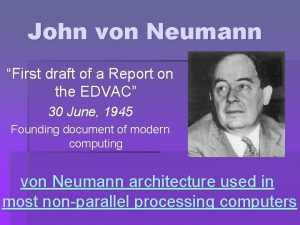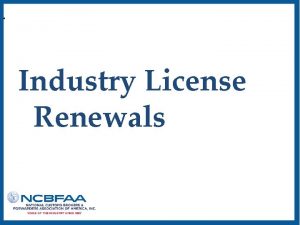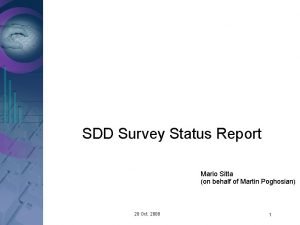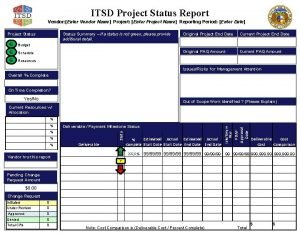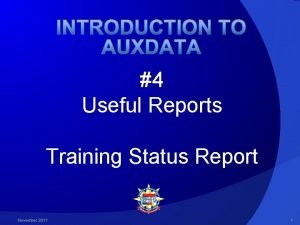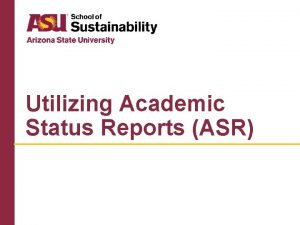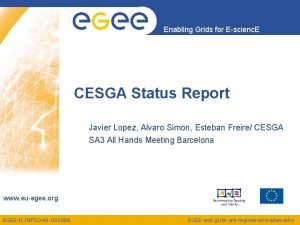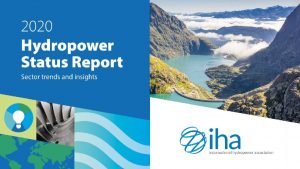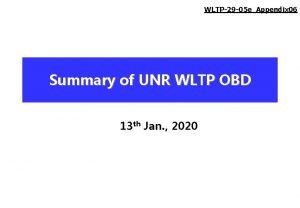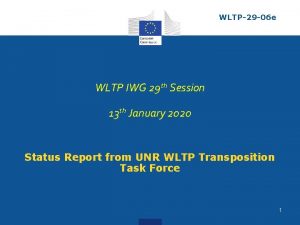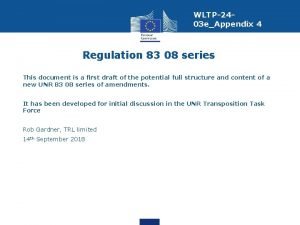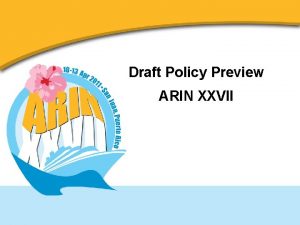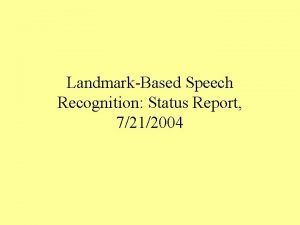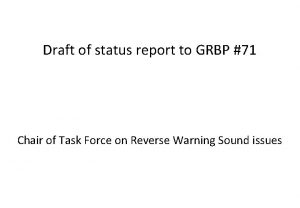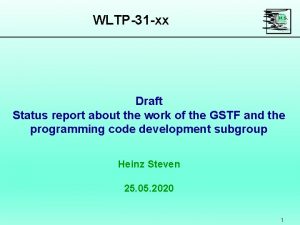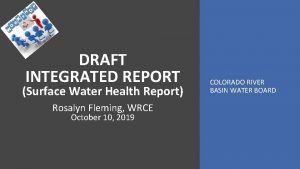WLTP29 05 eAppendix 03rev 1 Draft Status report













- Slides: 13

WLTP-29 -05 e_Appendix 03_rev 1 Draft Status report about the work of the programming code development subgroup of the GSTF Heinz Steven 30. 12. 2019 1

Introduction • At IWG #26 in Zagreb was agreed to establish a programming code development subgroup (PCD-SG). This subgroup started its work with a kick-off webtelco at 13. 05. 2019. The discussion about the programming language(s) led to the following result: • JRC will take the responsibility to develop a Python code based on the latest version of annex 2 of GTR 15 as adopted by the IWG in Zagreb. • This code will be the basis for the development of alternative codes in MATLAB and in. NET Core. The aim of adding the two other languages is to cover all programming languages currently used in the software of test bench equipment. 2

Introduction • The original time plan was as follows: Ø Delivery of the Python code till end of June 2019, Ø Delivery of the alternative codes in MATLAB and. NET Core till mid of September, Ø Validation and report for the IWG till mid of October 2019. • This time plan would have allowed to deliver the results (appendices for annex 2) just in time for the implementation in a working document for the January 2020 GRPE. • Unfortunately, JRC announced delay in the delivery of the Python tool, so that the time plan needed an update. 3

Updated time plan • In a web-telco at 6 th September 2019 the following updated time plan was proposed: Ø Mr. Schlichte (Matlab) and Mr. Adam (. NET core) should not wait for the Python tool but start their development work based on the latest ACCESS tool, which is also used as basis for the Python tool, so that all have the same basis. Ø And the new target for the finalisation of the prog codes including the delivery of the results for 124 vehicle configurations/calculation versions to be used for validation would be end of November 2019, so that the validation work can be done till the end of the year. 4

Updated time plan • After intense discussions the proposal of the SG leader was accepted by the group members and Kostis Anagnostopoulos promised to have the Python tool and the validation calculation results also ready till end of November. • This time schedule would allow to perform validation work till the end of 2019 and to prepare a report with the results for the January 2020 IWG meeting. • The Matlab code as well as the. NET core code were delivered in time (by end of November 2019) but the delivery of the Python tool is still pending. 5

Validation • The further part of the presentation is dedicated to the outcome of the validation work. • This work is based on the comparison of calculation results between the ACCESS tool, the Matlab code and the. NET core code for 115 different vehicle configurations supplemented by additional calculations for 7 of them with additional options like “apply speed cap”, “suppress downscaling”, “chose other vehicle class cycle” and “choose individual nmin_drive values”. • The total number of cases is 124. The technical data, the WOT power curves and the validation calculation results can be found in the Excel files in the annex at the end of this presentation. 6

Validation results • The further part of the presentation is dedicated to the outcome of the validation work. • This work is based on the comparison of calculation results between the ACCESS tool, the Matlab code and the. NET core code for 115 different vehicle configurations supplemented by additional calculations for 7 of them with options like “apply speed cap”, “suppress downscaling”, “chose other vehicle class cycle” and “choose individual nmin_drive values”. • The total number of cases is 124. The technical data and the WOT power curves can be found in the Excel file in the annex at the end of this presentation. 7

Validation results • The comparison of the results of the different tools (Matlab code, . NET code and ACCESS tool) had a quite positive result. • No differences in the gear use calculation were found except for cases, where the wrong cycle was used or the wrong downscaling was applied (see table 1). • The differences in clutch operation and engine speed are summarised in table 1. • Meanwhile, the remaining errors in the tools were eliminated, so that all three tools deliver identical results. 8

Validation results Table 1 9

Validation results Table 2 10

Further steps • The following further steps are proposed: Ø Test of the Matlab and. NET codes by other members of the prog code development SG or members of the GSTF till end of March 2020. Ø Preparation of appendices for annex 2 containing these codes till end of April 2020. Ø Delivery of the Python tool and its validation calculation results till end of April 2020. Ø Preparation of an appendix for annex 2 containing the Python tool till end of May 2020. Ø Delivery of the appendices to the IWG for discussion and adoption for the June 2020 meeting in Geneva. 11

End Thank you for your attention! 12

Annex Technical data of the validation cases Validation calculation results https: //www. magentacloud. de/lnk/xr. Cmh 7 Oz 13
 Objective of draw frame
Objective of draw frame Writing a status report
Writing a status report John louis von neumann
John louis von neumann Seo progress report
Seo progress report Annual status of education report
Annual status of education report Kaiser santa rosa er
Kaiser santa rosa er Triennial status report
Triennial status report Survey status report
Survey status report Enter vendor name
Enter vendor name Training status report
Training status report Asu academic status report
Asu academic status report Status report
Status report Hydropower status report
Hydropower status report Convercent report status
Convercent report status


